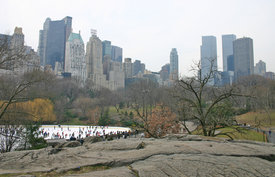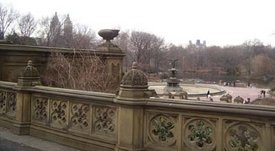Central Park
|
|
- For the Ottawa park by this name see Central Park (Ottawa)
Central Park (Template:Coor dms) is a large park (843 acres or 3.4 km²; a rectangle 2.5 miles by one-half mile, or 4 km × 800 m) in the borough of Manhattan in New York City. An oasis for Manhattanites escaping from their skyscrapers, the park is well-known worldwide after its appearance in many movies and television shows, which has arguably made it the most famous city park in the world.
Central Park is bordered on the north by Central Park North (which is Cathedral Parkway west of the park and 110th Street east of it), on the east by Fifth Avenue, on the south by Columbus Circle and Central Park South (which is 59th Street east of Fifth Avenue), and on the west by Central Park West (which is Eighth Avenue south of Columbus Circle).
CentralParkWithGatesFrom2000feet.jpg
The park was designed by Frederick Law Olmsted and Calvert Vaux, who later created Brooklyn's Prospect Park. While much of the park looks natural, it is in fact highly landscaped. It contains several artificial lakes, extensive walking tracks, two ice-skating rinks, a wildlife sanctuary, and grassy areas used for myriad sporting pursuits, as well as playgrounds for children. The park is a popular oasis for migrating birds, and thus is popular with bird watchers. The 9.7 km road circling the park is popular with joggers, bicyclists and inline skaters, especially on weekends when automobile traffic is banned.
Each summer, the Public Theatre presents free open-air theatre productions, often starring well-known stage and screen actors, in the Delacorte Theatre. Most, though not all, of the plays presented are by William Shakespeare.
Other events include NYC Midsummer and Summerstage, and the finish line of the New York Marathon.
| Contents |
History
Central Park was the first large landscaped park in an American city. The need for a great public park as New York City expanded was voiced by the poet William Cullen Bryant and by the first American landscape architect, Alexander Jackson Downing. A stylish place for open-air driving, like the Bois de Boulogne in Paris or London's Hyde Park, was a need felt by many influential New Yorkers. In 1853, the New York legislature designated an area from 59th to 106th Streets (a section from 106th to 110th Streets was added later) for the creation of the park, and a competition for a design was opened, and won the partnership of Olmsted and Vaux. Sculptural detail (see illustration) was provided by Jacob Wrey Mould. The park actually opened three years later, but celebrated its 150th anniversary in 2003.
Several influences came together in the design, called "Greensward" which won a blind competition, 1858. Landscaped cemeteries, such as Mount Auburn (Cambridge, Massachusetts) and Green-Wood (Brooklyn, New York) had set an example of idyllic naturalistic landscapes. The most influential innovations in Central Park's design were the separate circulation systems for pedestrians, horseback riders and pleasure vehicles, with "crosstown" commercial traffic (almost non-existent at the time of the design) entirely concealed in sunken roadways with densely planted shrub belts, so as not to disturb the impression of a rustic scene. There are some 36 bridges designed by Vaux, ranging from rugged spans of Manhattan schist or granite, to lacy neo-gothic cast iron, no two alike. The ensemble of the formal line of the Mall's doubled allées of elms culminating at Bethesda Terrace, with a composed view beyond of lake and woodland, is at the heart of the larger design.
The Saw Kill was dammed to make the Lake (illustration, left), and the spoil was laid as a curving earthen dam, with the carriage drive laid on it so naturally, that few today realize it is a dam. The solidly frozen Lake is a thing of the past, now that the Park is at the center of an urban heat island.
BelvedereCastle.JPG
Central Park was run down and hit a low at the end of the 1970s, when the Central Park Conservancy was founded (1980). The Conservancy restores and maintains the park under contract from the New York City Department of Parks and Recreation, an early successful public private partnership. The city has transferred direction of ongoing restoration and maintenance to the Conservancy.
Notable features of Central Park include Strawberry Fields, Bethesda Terrace, the Belvedere Castle.

Many encroachments on the park have been fought off over the years: within the Park are the Metropolitan Museum of Art, and the Central Park Zoo, ranged behind the pre-existing Arsenal, Manhattan's oldest.
Although often regarded as a kind of oasis of tranquility inside a "city that never sleeps," Central Park has had a reputation over the years as a dangerous place, especially after dark. Well-publicized incidents of violence and rape, such as the infamous "Central Park Jogger" case, have contributed to this perception. However, as crime has declined in the Park and in the rest of New York City, many of these perceptions have become exaggerated or outdated, and the use of common sense is enough to protect visitors from harm. The New York Police Department designates Central Park as its own precinct, the 22nd, and it has been noted that a large percentage of the crimes in the park, particularly assaults, occur between people who know each other, as opposed to being random attacks. With more than 25 million visitors annually and fewer than a hundred crimes in all of 2004, Central Park is by far one of the safest urban parks in the world.
Sculptures
Centralpark_20040520_121402_1.1504.jpg
Though Olmsted disapproved of the clutter of sculpture, a good deal has crept in. Much of the first statuary to appear in the park was of authors and poets, clustered along a section of the Mall that became known as Literary Walk. The better-known sculptors represented in Central Park include Augustus Saint-Gaudens and John Quincy Adams Ward.. The "Angel of the Waters" at Bethesda Terrace by Emma Stebbins, 1873, was the first large public sculture commission for an American woman. The 1926 statue of the sled dog Balto who became famous during the 1925 serum run to Nome, Alaska is very popular among tourists. The oldest sculpture is "Cleopatra's Needle," actually a much older Egyptian obelisk, of Tutmose III, donated to New York by the Khedive of Egypt. North of Conservatory Water, the sailboat pond, there is a larger than life statue of Alice, sitting on a huge mushroom, playing with her cat, while the Hatter and the March Hare look on. A large memorial to Duke Ellington created by sculptor Robert Graham was dedicated in 1997 at near Fifth Avenue and 110th Street, Duke Ellington Circle.
Miscellaneous issues
The New York Philharmonic gives an open-air concert every summer on the Great Lawn and the Metropolitan Opera presents two operas. Many concerts have been given in the park: the Simon and Garfunkel reunion; Diana Ross, 1983.
The Central Park Medical Unit is an all-volunteer ambulance service that provides completely free emergency medical service to patrons of Central Park and the surrounding streets. CPMU also operates a rapid-response bike patrol, particularly during major events such as the New York City Marathon, the 1998 Goodwill Games, and concerts in the park.
In 2004, the organization United for Peace and Justice wanted to hold a rally on the Great Lawn in opposition to the continued occupation of Iraq. The City denied UFPJ's application for a permit, on the basis that a mass gathering on the Great Lawn would be harmful to the grass, and that such damage would make it harder to collect private donations to maintain the Park. UFPJ charged that Mayor Michael Bloomberg was willing to allow other large gatherings on the Great Lawn, but was discriminating against the demonstration so as to curry favor with the Republican Party, which was holding its quadrennial convention in New York City. Nevertheless, a court rejected UFPJ's challenge to the denial of the permit.
Central Park has one of the last stands of American Elms in the northeastern U.S., 1700 of them, protected by their very isolation from Dutch Elm Disease. Central Park was the site of the unfortunate unleashing of starlings in North America (cf. Invasive species) Over a quarter of all the bird species found in the United States have been seen in Central Park.
In 2002 a new genus and species of centipede was discovered in Central Park. The centipede is about four-tenths of an inch long, making it one of the smallest in the world. It is named Nannarrup hoffmani (after the man who discovered it) and lives in the park's leaf litter, the crumbling organic debris that accumulates under the trees.
Since the late 1990s, the Central Park Conservancy, the United States Department of Agriculture, and several city and state agencies have been fighting an infestation of the Asian longhorned beetle, which has been reported in Brooklyn, Queens and Manhattan, including some parts of Central Park. The beetle, which likely was accidentally shipped from its native China in an untreated shipping crate, has no natural predators in the United States and the fight to contain its infestation has been very expensive. The beetle infests trees by boring a hole in them to deposit its eggs, at which point the only way to end the infestation is to destroy the tree.
| To the west: Central Park West | Geography of New York City: Central Park | To the east: Fifth Avenue |
See also
- The Gates, a land art project realised by Christo and Jeanne Claude in Central Park in the first two months of 2005
- Central Park is also the name of a fast food restaurant chain in the southern United States. See Central Park (restaurant).
The_Gates_from_The_Met_2005-02-18.jpeg
References
- Art of the Olmsted landscape, Bruce Kelly, Gail T. Guillet, and Mary E. W. Hern, NY, City Landmarks Preservation Commission: Arts Publisher, 1981. SB470 .O5 K44
External links
- Official New York City Parks site (http://www.nycgovparks.org/sub_your_park/vt_central_park/vt_central_park.html)
- Satellite photo (http://terraserver.microsoft.com/image.aspx?S=14&T=1&X=183&Y=1410&Z=18&W=1&ref=F%7cCentral+Park%2c+Manhattan)
- Central Park Aerial View. (http://boldt.us/places/nyc/central_park/central-park-aerial-view.html)
- Central Park Conservancy website. (http://www.centralparknyc.org/)
- The bridges of Central Park, photographs and text. (http://www.forgotten-ny.com/STREET%20SCENES/arches/arches.html)
- The Central Park Zoo Book, photographs and text. (http://www.cpzbook.com/index.html)
- Graphicalic - pictures from Central Park (http://www.graphicalic.dk/pages/photo/usa/park.html)
Template:Mapit-US-cityscalede:Central Park fr:Central Park it:Central Park he:סנטרל פארק nl:Central Park no:Central Park pt:Central Park sv:Central Park




